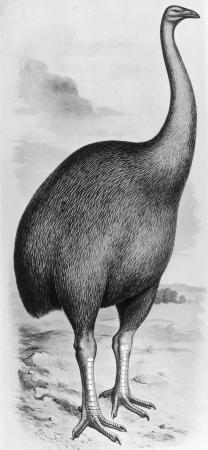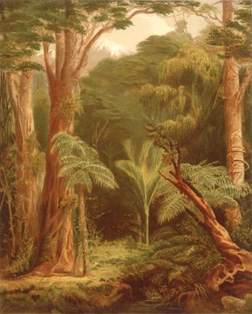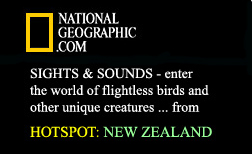|
Photo Credit
Center top: Cathedral Cove, Coromandel Marine Reserve
Crown Copyright ©
Department of Conservation
Illustration Credit
Left above 3rd down:
John Gerrard Keulemans
1842-1912, Huia (male
and female) Heteralocha
acutirostris 1888
Right, top:
John Gully 1819-1888,
New Zealand forest
(bush) vegetation,
Dunedin 1877.
Center bottom:
Frederick William Frohawk
1861-1942,
Dinornis ingens 1906.
Permission of the Alexander Turnbull Library, Wellington, New Zealand must be obtained before
any re-use of these images. |
|
|
| |

|
| |
|
Since European discovery of New Zealand, it has been realised that the islands had
been isolated from the rest of the world for a long time. Advancement of plate
tectonic theory and synthesis of the earth sciences during the last 30 years, now
provide reasons for the country's isolation.
New Zealand was originally part of the ancient southern super continent, Gondwana,
which consisted of the major continents that are now Australia, South Africa, South
America, India and Antarctica. Until Jurassic times, it lay beneath a shallow
sea, dotted with volcanic islands. |
Small islands remain today in these extremities of the former continent, like New
Zealand's subantarctic Campbell, Antipodes, Auckland and Snares Islands; Australia's Lord
Howe and Norfolk Islands in the west, and New Zealand's Chatham Island in the east.
Flora and fauna developed during this period, that became endemic to New Zealand.
This was the first land mass to separate from the southern continent 80 million
years ago - the beginning of a unique biological evolution. Some species,
including New Zealand's dinosaurs, became extinct, while others adapted and changed
through severe climate changes and huge geological processes, as the land moved on
the earth's surface and was eroded down and uplifted again.

When the first human settlers arrived in New Zealand from Polynesia in the
13th century, they found a terrestrial flora and fauna unique in the world. Some
species had developed from ancestors that evolved in the original Gondwana, and others
had arrived over millions of years. The Polynesians found a land that was 85 percent covered
with forest and large shrubs, with 80 percent of the plants endemic to New Zealand. |
The terrestrial fauna was even more remarkably endemic, with very limited variety. The only land-dwelling representatives of reptiles, mammals and amphibians were four small frogs, several lizards, the tuatara, and three bats.
The first humans found an abundance of birds, many of large proportion, but restricted in the variety of species. The bird fauna had evolved for millions of years in a non-mammalian predator free environment, which was reflected by a large number of species that were flightless or were poor fliers. Ratites proliferated in particular, with the largest moa (right), developing unopposed into the tallest bird the world has ever known. |
 |
|
| |
 |
"New Zealand's biota is interesting on an international scale for many reasons .....
though one usually thinks of New Zealand as an island or archipelago, it is one of the world's smallest continents, defined biogeographically as a land mass within which birds and mammals can achieve completed speciation not dependent on water gaps. Its biota arrived both over water during a long time and over land in the far-distant past, and then redistributed itself within the modern New Zealand archipelago both over land (at Pleistocene times of low sea level) and over water .....
The biotas of New Zealand and Madagascar are the closest we shall ever come to observing the products of continental evolution in island-like isolation, unless we discover higher life on another planet .....
New Zealand is distinctive in the two-stage destructive impacts it received from human colonists, and in the innovativeness with which its' biologists are now seeking to mitigate those impacts .....
..... all these features make New Zealand one of the world's biological prizes."
Jared Diamond, Professor of Physiology, University of California Medical School, Los Angeles. |

 |



